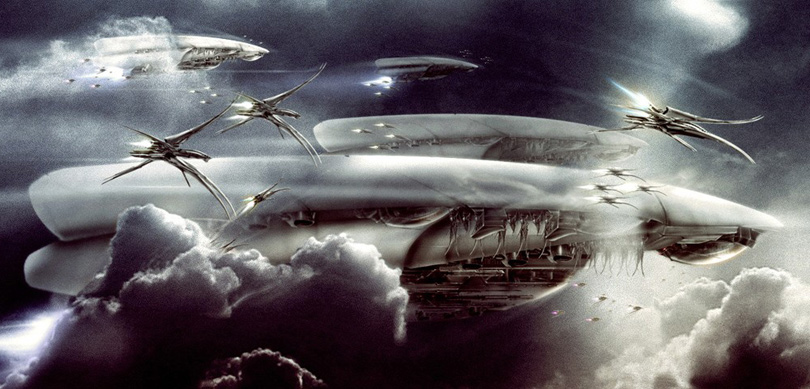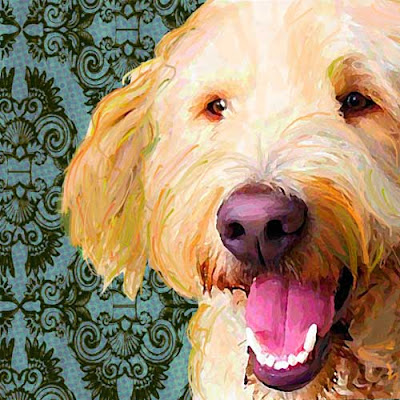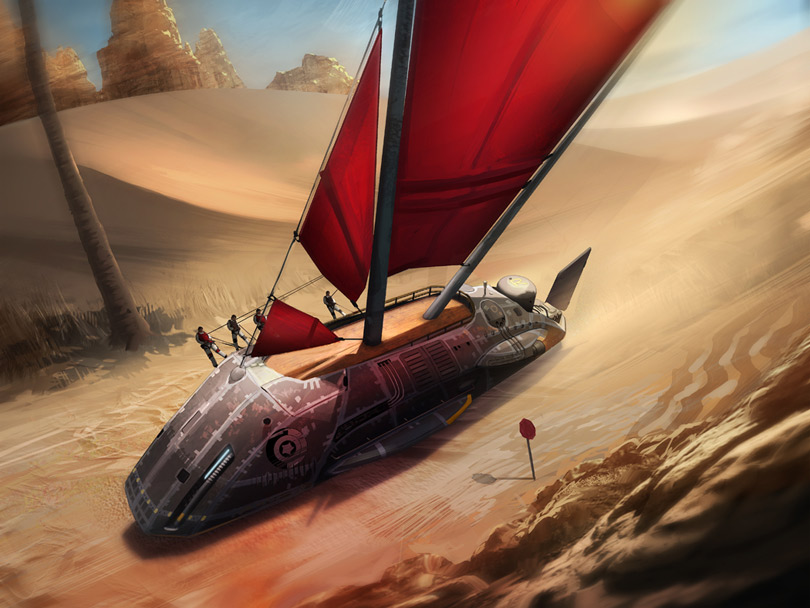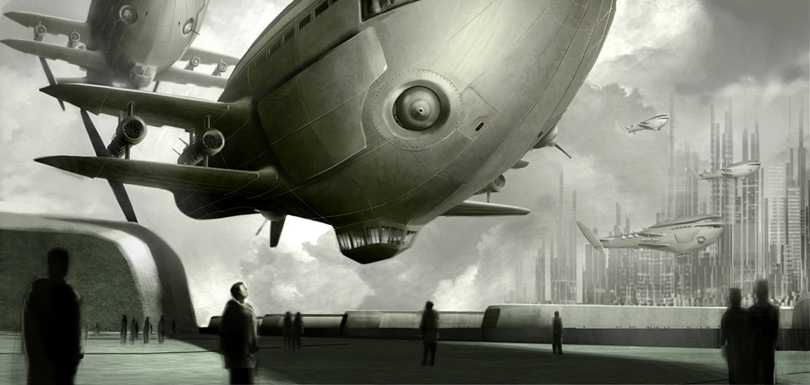 [Comparative Analogy II by Michael Cheval]
[Comparative Analogy II by Michael Cheval] is that the writer gets to enter the world of the artist’s creations. Obligingly, the reader follows as the writer gently leads her into another dimension, another continent of possibility. Perhaps no other living artist deserves a guide, a shaman, for his works than the Russian master, Michael Cheval.
I am no shaman; but I will lead.
I set out to write illustration art reviews for
Escape into Life, but inevitably I stepped into a brier patch of fine art, notably Cheval’s. The instant I saw his work, I knew I had to write about it. The images had cast a spell on me . . .
There is magic in this artwork. Not only are the paintings populated with magical characters, court jesters, and magicians themselves, but a supernatural magic suffuses each painting like the flower juice Oberon orders Puck to drop into Titania’s eyes as she’s sleeping in
Midsummer Night’s Dream. “Love-in-Idleness” is the name of the flower in the play. Likewise, Cheval’s artwork conjures visions of supernatural spheres, doorways into parallel realities, and glimpses into absurdist theaters.
Absurdity is Cheval’s main subject. But he creates his own definition of absurdity, which his paintings seek to reveal. To Cheval, absurdity is a “game of the imagination, where all ties are carefully chosen to construct a literary plot.” In addition, he says that absurdity is “an inverted side or reality, a reverse side of logic.”
Cheval’s works are grouped into themes; "Nature of Absurdity", "Eternity of Absurdity", "Illusions of Absurdity", "Reality of Absurdity", and "Sense of Absurdity".
The shape of a dress or a faucet will become another object, a surreal object, such as a table or a horn instrument; but it will retain the original shape of the dress or the faucet. Such are Cheval’s games of the imagination; we do not always know what we are looking at. The eye must adjust to the picture object-by-object as it simultaneously takes in a new chessboard of reality.
Despite the illogic pervading the works, there is a coherency of representation. The heightened realism reminiscent of 17th century Dutch art does just that—the precision knits our illusions together to such a degree that we see Cheval’s paintings as actualities playing out in another dimension.
There are so many delectable images on Cheval’s website, and a viewer can spend hours looking at them, lost in a labyrinth of dreams; but for the sake of review, I will talk about two of my favorites.
 [Air of Attraction by Michael Cheval]
[Air of Attraction by Michael Cheval] in the jester’s costume holding a lute, and with the slightest turn of his head, looking outside of the painting. The painting is called, “Air of Attraction.”
It seems he’s sitting on a green velvet pillow in the middle of a dirt road. But the dirt road, like the boy himself, is illuminated by sunshine, and green plants and grass grow right beside him. The boy’s costume is distinctive. He wears a floppy jester’s hat with four prongs and jingle bells on the end. He wears white stockings and purple knickers, and his dress seems more meant for the royal court than the middle of a road. But there he is, playing his lute and dreaming off into the distance.
Gravity or the lack thereof plays a large part in Cheval’s parallel realities. And here we see some apples on the ground (obeying gravity) and one apple floating above the boy’s head (not obeying gravity). The boy doesn’t look at the apple, but just under it; his gaze fixed by an innocent daydream as he plays his instrument. We almost hear the measure of delay between the plucked strings and are drawn along with him into a current of distraction.
And what does the title mean? Perhaps the “air of attraction” is how involuntary attention comes across us like a spell and makes us all children for its duration. The child represents this phenomenon best because it is during childhood that we are engrossed in our games and our imaginary worlds. Moreover, the painting has an intangible quality of air; the sunlight on the dirt, the bright colors of the boy’s costume, the boy’s eyes lost in distraction, the floating apple; all of these elements conjure a sense of the ethereal. It is as if a supernatural law is guiding our distractions and attractions.
 [Lullaby for the Hero by Michael Cheval]
[Lullaby for the Hero by Michael Cheval], “Lullaby for the Hero”, and in this case our hero is another little boy. A mime in gold and crimson-striped tights and regal Late Stuart costume holds the boy in his arms. The boy is dressed in armor and a royal blue cape; he holds a lance pointing down and stares directly at us. The mime is looking off to the side. It appears as if there was some horseplay, the mime has just picked the boy up off the ground, and now the scene is fixed in stillness. The knocked-over chair suggests this earlier bit of chaos.
The boy’s sister (presumably) holds a magic wand and looks dazed by her own magic. She is in the picture but not
in it. Her gaze betrays her. She wears a baroque pink dress with a collar. Contrast her eyes, mesmerized--to her brother’s eyes, which are alert and aware of us. The toys on the floor of the children’s playroom, a wooden rocking horse with a bicycle chain, a globe, alphabet blocks, and a train, are like riddles. Why is there a toy train if trains haven’t even been invented yet? And what century is this exactly? The costumes seem to place it in the 17th century, but did they even know the world was round at that time?
And then, the most powerful image looms in the background. The wall of the children’s playroom is a gray-scale mural of a war battle with men on horses. A violent, bloody scene, it reminds me of the Shield of Achilles in
Ulysses. The shadow-play over the gray-scale mural adds to the gloominess of it. The mural is actually Leonardo Da Vinci's
"Battle of Anghiari".
The connection between the boy’s play-armor and the “real” battle on the wall has many different connotations. Does the mural forebode a war that the boy, when he grows up, will fight in and perhaps die? Or is the mural there only to reveal the other side of child-hero's play world? Could the children be acting out an adult world in their playroom? And if so what does the little girl in pink represent? She doesn’t seem to belong in the “real world”. But the boy, who stares at us, knows he belongs.
The mime is a particularly evocative figure to me.
My mother was an oil painter and she used to dress up in a mime’s costume and paint herself, looking into a mirror. I remember her with the white face makeup and the blank, bemused expression just like the mime in “Lullaby for the Hero.”
Who is singing the lullaby? The mime is the artist and his song breaks the boy’s fierce play-acting; the song puts his wild fantasies to rest. He is only a boy-hero for now, not a real hero yet.
In his essay, “Abusurd Intacta,” Mark Gauchax writes:
Instead of relying on cultural sources, he (Cheval) explores deep motives of unconsciousness that are easily understood because they are universal, regardless of one’s geography, experience or knowledge. His paintings lead their independent life. Outside of time and space, this artist spends too much time communicating with specters.
The few cultural and historical references we have in Cheval’s paintings, 17th century dress, courtly figures, jesters, are all jumbled. The narrative is not linear; as Gauchax writes, the paintings cut through historical time and the probabilities of space. What we connect with, then, what we make sense of,
is our own subconscious.
As the mime in “Lullaby for the Hero” becomes my own mother who has passed away, I slowly begin to see myself in every little boy that Cheval has ever painted. And the magic, Oberon’s magic, Cheval’s magic, Shakespeare’s magic, is the belief that I am represented here, and here, and here . . .
Michael Cheval's Website
 As if I don't have enough works in progress already with Star Trek and comic book character mask projects, I have started working on some papercraft based on 3D models ripped from Tron 2.0. Tron 2.0 is a 2003 video game which should not to be confused with Tron 2 the movie sequel scheduled to be released in 2011. For those unfamiliar, the story lines of both the original 1982 movie and the video game involve humans who are transported to an electronic realm inside a computer where programs appear as living beings. This papercraft is of goggles worn by "Resource Hogs", typical enemy programs in the video game. Template info is as follows:
As if I don't have enough works in progress already with Star Trek and comic book character mask projects, I have started working on some papercraft based on 3D models ripped from Tron 2.0. Tron 2.0 is a 2003 video game which should not to be confused with Tron 2 the movie sequel scheduled to be released in 2011. For those unfamiliar, the story lines of both the original 1982 movie and the video game involve humans who are transported to an electronic realm inside a computer where programs appear as living beings. This papercraft is of goggles worn by "Resource Hogs", typical enemy programs in the video game. Template info is as follows:























































